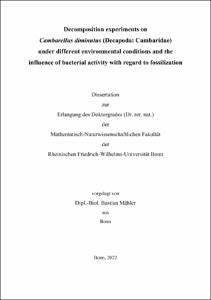Mähler, Bastian: Decomposition experiments on Cambarellus diminutus (Decapoda: Cambaridae) under different environmental conditions and the influence of bacterial activity with regard to fossilization. - Bonn, 2022. - Dissertation, Rheinische Friedrich-Wilhelms-Universität Bonn.
Online-Ausgabe in bonndoc: https://nbn-resolving.org/urn:nbn:de:hbz:5-68166
Online-Ausgabe in bonndoc: https://nbn-resolving.org/urn:nbn:de:hbz:5-68166
@phdthesis{handle:20.500.11811/10312,
urn: https://nbn-resolving.org/urn:nbn:de:hbz:5-68166,
author = {{Bastian Mähler}},
title = {Decomposition experiments on Cambarellus diminutus (Decapoda: Cambaridae) under different environmental conditions and the influence of bacterial activity with regard to fossilization},
school = {Rheinische Friedrich-Wilhelms-Universität Bonn},
year = 2022,
month = sep,
note = {A fossil only occurs if certain decay processes take place and/or are interrupted. Microorganisms have an important influence on the environmental conditions, caused by their metabolic products and the formation of biofilms. Abiotic factors such as pH, oxygen content, salinity, and temperature influence the microbial activity. In the fossil record soft tissues are generally preserved as pseudomorphs in which the organic material is often replaced by carbonate, phosphate, or pyrite.
Observations of decomposing crayfish (Cambarellus diminutus) in freshwater revealed a precipitation of calcite structures and a mineralization of muscle fibers. It could be proven that calcium ions that are needed for the precipitation of calcite were mostly provided by the carcasses themselves. Individuals which were in the postmoult phase showed a smaller total volume of precipitated calcite, compared to specimens that were in the intermoult or premoult phase. It is assumed, that the higher the body size the higher the precipitated calcite, if the animals were in the intermoult phase at the time of death. If the individuals were in the premoult or postmoult phase, the phase itself seems to be important.
Further experiments showed fine grained calcite crystals in animals, that were enveloped by biofilms. These crystals replicated the structures of the cuticles better than the coarse precipitates that occurred without a biofilm.
In addition, a transformation of the digestive gland into adipocere was proven, but only inside a biofilm. Under certain circumstances bacteria are able to degrade adipocere, which will later be replaced by pyrite. Therefore, it is assumed that in some cases adipocere is a first step in soft tissue preservation as a shaping component.
A study with eight experimental setups differed in temperature, oxygen level, and treatment of water and sediment revealed a minimal influence on decay at a constant temperature of 24°C. Experiments that were conducted at 4°C revealed a faster decomposition of stomach and digestive gland under partly anaerobic conditions than under aerobic conditions. Gut and nerve tissue have been decomposed at 4°C only under partly anaerobic conditions and in untreated water and sediment. At 24°C a higher precipitation of calcite was noticed in animals that decomposed in untreated water than in animals which decayed under sterile conditions. Caused by microbiological investigations it is assumed that the bacterial genus Proteocatella might be responsible for the difference in calcite precipitation.
It seems that the decomposition of soft tissue cannot be generalized, but is a complex interaction of tissue type, oxygen level, temperature, and microbial influence.},
url = {https://hdl.handle.net/20.500.11811/10312}
}
urn: https://nbn-resolving.org/urn:nbn:de:hbz:5-68166,
author = {{Bastian Mähler}},
title = {Decomposition experiments on Cambarellus diminutus (Decapoda: Cambaridae) under different environmental conditions and the influence of bacterial activity with regard to fossilization},
school = {Rheinische Friedrich-Wilhelms-Universität Bonn},
year = 2022,
month = sep,
note = {A fossil only occurs if certain decay processes take place and/or are interrupted. Microorganisms have an important influence on the environmental conditions, caused by their metabolic products and the formation of biofilms. Abiotic factors such as pH, oxygen content, salinity, and temperature influence the microbial activity. In the fossil record soft tissues are generally preserved as pseudomorphs in which the organic material is often replaced by carbonate, phosphate, or pyrite.
Observations of decomposing crayfish (Cambarellus diminutus) in freshwater revealed a precipitation of calcite structures and a mineralization of muscle fibers. It could be proven that calcium ions that are needed for the precipitation of calcite were mostly provided by the carcasses themselves. Individuals which were in the postmoult phase showed a smaller total volume of precipitated calcite, compared to specimens that were in the intermoult or premoult phase. It is assumed, that the higher the body size the higher the precipitated calcite, if the animals were in the intermoult phase at the time of death. If the individuals were in the premoult or postmoult phase, the phase itself seems to be important.
Further experiments showed fine grained calcite crystals in animals, that were enveloped by biofilms. These crystals replicated the structures of the cuticles better than the coarse precipitates that occurred without a biofilm.
In addition, a transformation of the digestive gland into adipocere was proven, but only inside a biofilm. Under certain circumstances bacteria are able to degrade adipocere, which will later be replaced by pyrite. Therefore, it is assumed that in some cases adipocere is a first step in soft tissue preservation as a shaping component.
A study with eight experimental setups differed in temperature, oxygen level, and treatment of water and sediment revealed a minimal influence on decay at a constant temperature of 24°C. Experiments that were conducted at 4°C revealed a faster decomposition of stomach and digestive gland under partly anaerobic conditions than under aerobic conditions. Gut and nerve tissue have been decomposed at 4°C only under partly anaerobic conditions and in untreated water and sediment. At 24°C a higher precipitation of calcite was noticed in animals that decomposed in untreated water than in animals which decayed under sterile conditions. Caused by microbiological investigations it is assumed that the bacterial genus Proteocatella might be responsible for the difference in calcite precipitation.
It seems that the decomposition of soft tissue cannot be generalized, but is a complex interaction of tissue type, oxygen level, temperature, and microbial influence.},
url = {https://hdl.handle.net/20.500.11811/10312}
}






